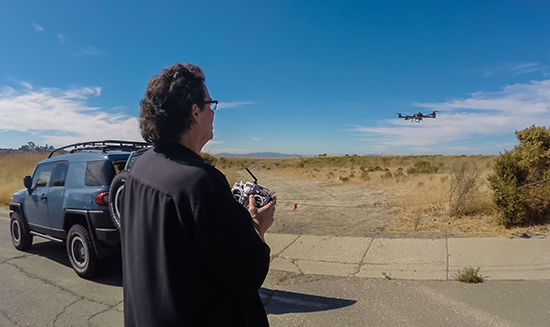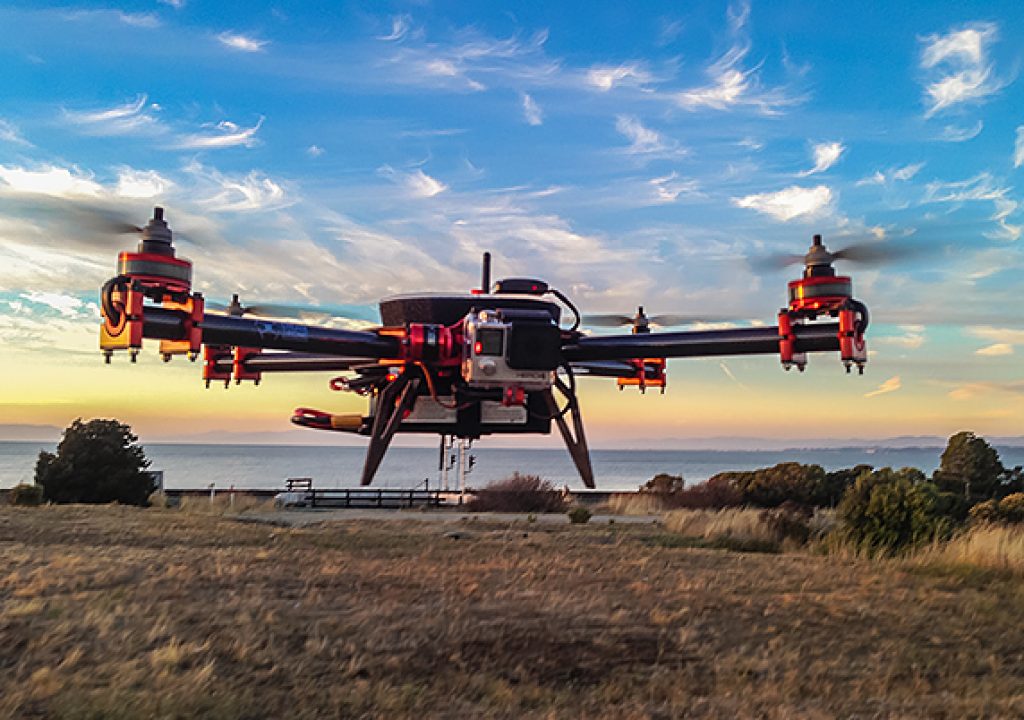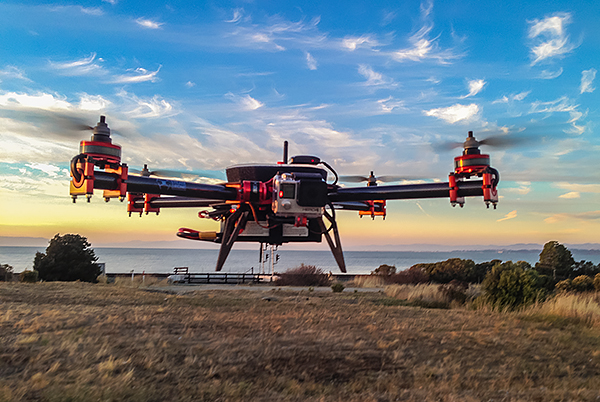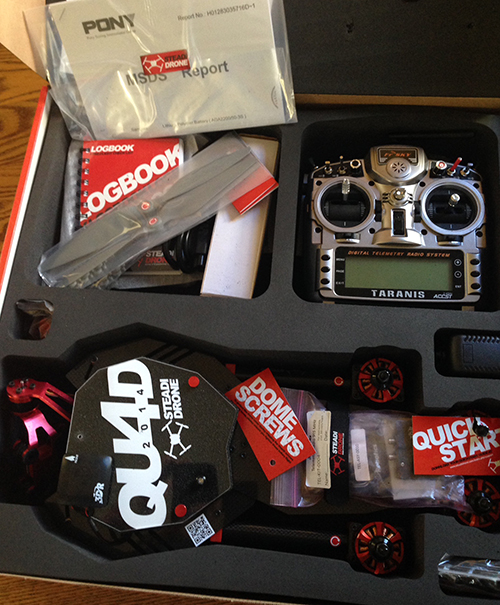This UAV manufacturer based out of South Africa has set out to make durable, stable and easy to transport designs that run on the popular 3D Robotics Pixhawk GPS Flight Controller and provide smooth footage for a GoPro HERO4 in a brushless gimbal. I think they’re on to something here…
SteadiDrone QU4D 2014
When I was first contacted by SteadiDrone to take a look at their QU4D 2014 I was intrigued by its unique design and beefy construction. When I learned that it used the Pixhawk GPS Flight Controller I agreed to take one for a spin. (Note that you can also choose to get the DJI NAZA V2+GPS flight controller configuration as well).
Being already familiar with the 3D Robotics Pixhawk and its capabilities such as Stabilize/Loiter modes and mapping with an Android tablet and DroidPlanner 2 app, I wanted to see how this quad performed.

Photo credit: Terrence Jerod
The first thing you notice when you take it out of the box is how easy it is to assemble and prep for the first flight. The adjustable arms are easy to unfold and click into position with retaining clips. The construction is plates made of CF (carbon fiber) with an open-cell foam cap over the Pixhawk and telemetry controls and a clear Plexiglas top with the product name silkscreened on top. This helps keep the most critical electronics protected from dust and moisture, yet keeps them cool.
The arms are made from heavy duty CF rods which are strong and lightweight.
The form factor of this craft when fully assembled is a wide-stance X-quad with the weight of the battery off the tail. Although it can also be configured to place the battery square under the craft’s belly and adjust the arms to a true X formation (shown later in this article).
The nice part about the clips that hold the arms stable for flight is that they give under any kind of force like impact with objects or a hard landing – which the design keep your airframe fly-able and the components protected (yes, I found this out the hard way already – totally misjudged my distance from a light pole since I wasn’t flying with FPV).
The integrated 2-axis gimbal is robust and holds your GoPro inside its protective housing, unlike most other gimbals on the market. It’s also adjustable to tweak the balance, but mine came pre-balanced and worked well with the new GoPro HERO4 Black.
At first you might think this thing is over-built for moving a GoPro around in the air – it’s mass is effective to providing good stable aerial footage while hovering in Loiter mode. But switch this beast to Stabilize mode and you’ll have a very fast craft that can easily hold its own with the competition. Enough to create some vibration in the video and make the gimbal work pretty hard – to the breaking point at times. But typically, if you’re planning on shooting acrobatics and wild flying formations with any drone, you’re better off NOT using a gimbal and instead just shock-mounting your GoPro to the frame and shooting FPV style like a fixed-wing craft.
To gain a sense of what this thing is capable of, check out this promo video off the SteadiDrone website:
CONTINUED ON NEXT PAGE –>
QU4D Features & Specs from their Website:
- Integrated 2-axis brushless gimbal, tilt control, gimbal on/off switch, GoPro compatible, all powered by AlexMos
- Designed for the GoPro 3+.
- Advance flight control system options with full GPS navigation, GPS, Altitude, manual, failsafes, return home etc
- 16ch 2.4Ghz Digital radio controller system with advanced programming options, voice feedback and much more
- SteadiDrone 2X Vibration Reduction System built into the airframe motor mounts and 2 axis brushless gimbal
- ‘Quick Deploy’ Folding airframe arms and landing gear gets you ready to fly in seconds without the need for tools!
- Support for X8 configuration, simply add 4 x motor mounting plates for co-ax motor setups
- Tool-less entry clear top dome with splash and dust proof filtrex® foam enclosure to keep your electronics safe
- Ultra durable and great looking carbon fiber construction that will save you money in the long run
- Agile and high speed, high performance airframe design with various flight modes and prop size options
- Modular construction, easy to assemble with affordable spare parts
- Optional carbon fibre prop guards, support up to 12″ props
Advanced GPS Features
- 3DR Pixhawk* GPS Flight controller with advanced GPS Features
- ‘Follow Me’ Have the QU4D follow you or your subject around
- ‘Loiter’ Accurate GPS position and altitude hold modes keep your drone where you want it
- ‘Return to Home’ With a flip of the switch have the drone return home and land autonomously
- Advanced Waypoint navigation, mission planning and more!
What you get with the SteadiDrone QU4D Ready To Fly
- SteadiDrone QU4D system, built, tested and ready to fly out the box!
- Integrated 2 axis brushless gimbal powered by AlexMos
- 4 x 650Kv 3506 powerful and efficient SteadiDrone brushless motors
- 25A Quattro ESC Motor controller
- 4 x 10” APC MR Props
- Advanced GPS Flight controller (3DR option includes Data Telemetry System!)
- 16Ch FRSKy Taranis 2.4Ghz Advanced digital radio system
- 5200mah 4S SteadiDrone power pack – up to 18 minutes flight time!
- AC/DC Battery charger kit
- Lipo alarm checker
- Free SteadiDrone lanyard, SteadiDrone Flight logbook & SteadiDrone sticker
- SteadiDrone QU4D travel box with foam insert and handle to take your QU4D with you everywhere!
- Everything you need to take to the skies with the best folding quadcopter on the market!
- SteadiDrone propeller tool
Specifications
- Camera Options – GoPro 3+ in hard case
- Flight times – Up to 18 minutes with full setup
- Payloads – 100 to 400g / max 800g
- Range – up to 2km
- Weight (Excluding battery & payload) – 1500g
- Width (Front arms) – 61.5cm
- Width (Diagonally) – 64.5cm
- Height (Landing gear unfolded) – 16.5cm
- Folded Size (L x W x H) – 45.5 x 20 x 10
SteadiDrone Overview Video:
One modification I did was to the foam covering the Pixhawk unit, as I wanted to be able to see the flight control LED – I used a box cutter and made an opening above the LED so it’s now visible when the craft is starting up on the ground.
I also wanted to try to fly it on both configurations and use a larger 6000mAh battery with it to increase flight times closer to 20 minutes, so I removed the back battery plate and moved the battery to the belly of the craft and adjusted the arms to the X-formation. In this mode you definitely get the props in your shot when the camera is facing forward, but shooting at 4K give you room to crop the image as well.
I’m very impressed with this craft so far – very solid and well designed and well-built. You can tell a lot of detail went into its construction and I’m looking forward to flying it with some more accessories and in different scenarios (like mission planning with DroidPlanner 2 software on the Nexus 7 tablet). I will update this article with new content as I have more tests and shots available.
For more info on the SteadiDrone QU4D, visit their website.
_____________________________________________________________________________________
Jeff Foster is a published author of several how-to books and training videos in the motion graphics, animation and video production industries and is an award-winning video producer and artist. Visit his web site to learn more about his training methods, tips & tricks at PixelPainter.com




